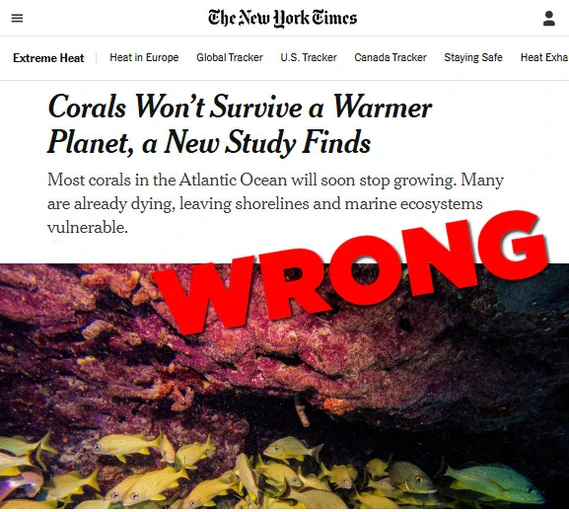
In a recent The New York Times’ article, “Corals Won’t Survive a Warmer Planet, a New Study Finds,” Sachi Kitajima Mulkey reports that nearly all Atlantic corals will cease growing by the end of this century due to projected rising temperatures. The article claims that over 70 percent of reefs will begin dying by 2040, and that 99 percent could vanish if global warming exceeds 2°C. This is false. The piece frames corals as doomed victims of climate change, unable to adapt to increased temperature, but paleoclimate data and peer reviewed research refute the NYT’s assertions.
From an interview, the NYT article quotes University of Exeter geoscientist Chris Perry, one of the authors of a new study on coral, which was published recently in the journal Nature. Perry claims, “We’ve seen off-the-scale warming, the magnitude and longevity of which has never been seen in the region.” Study co-author Alice Webb adds that “the reefs have changed so much that they’re not even slightly doing what the reefs of the past used to do.” These sweeping statements, framed as scientific consensus, form the backbone of the NYT narrative that corals are incapable of surviving the modest warming projected this century.
But both history and peer-reviewed science show otherwise. Corals are among the most ancient and resilient organisms on Earth. As explained in Climate at a Glance: Coral Reefs, coral thrive in warm water, not cold water and have existed continuously for the past 60 million years, surviving temperatures and carbon dioxide levels significantly higher than what is occurring today. They have survived mass extinctions, ice ages, and periods far hotter than today.
During the Holocene Climate Optimum, roughly 7,000–5,500 years ago, global and regional sea-surface temperatures were warmer than present. A 2025 study in The Holocene found that corals in Indonesia’s Spermonde Archipelago not only endured these conditions but thrived, growing at rates of around 6 mm per year as sea levels rose more than two meters above current levels. Rather than collapse, reefs expanded, demonstrating adaptability to precisely the kinds of environmental shifts now being portrayed as existential threats.
Similarly, Climate Change Weekly #556 summarized multiple lines of research confirming that corals have long flourished in warmer seas. The weekly bulletin noted that Indo-Pacific reefs grew more vigorously during past warm phases, while growth slowed during cooler intervals. Far from proving fragility, the paleoclimate record shows corals are highly adaptable, but in general better suited to warmer conditions than cooler ones. This historical evidence undermines the claim that today’s modest warming spells certain doom.
Another distortion in the NYT article is the treatment of coral bleaching as synonymous with coral death. Bleaching, the temporary expulsion of symbiotic algae, can result from multiple stressors, including salinity changes, sediment, or solar radiation— and cold temperatures, not just heat. More importantly, in most instances, coral recover from bleaching events, often quite quickly. As Climate at a Glance: Great Barrier Reef documents, the Great Barrier Reef has repeatedly bounced back from bleaching episodes, and in recent years it reached record-high coral cover. Bleaching is not a death sentence—it is a stress response in coral ecosystems that have evolved to recover from it.
The NYT also leans heavily on climate models to project catastrophic futures, while downplaying observations. As Climate Realism has shown, model-based predictions of coral decline have consistently failed. In the 1990s, models warned the Great Barrier Reef would be in terminal decline by the 2020s. Yet recent observational surveys show it thriving, with coral cover expanding in multiple subregions as seen in the figure below. Models that treat corals as passive victims ignore their demonstrated capacity to adapt through natural selection, range shifts, and symbiotic adjustments.
Even the oft-cited “ocean acidification” threat is overstated. Oceans remain firmly alkaline, and as Climate at a Glance: Ocean Acidification explains, corals are found thriving in areas with naturally lower pH, such as volcanic CO₂ seeps. The simplistic claim that incremental pH change will dissolve coral reefs ignores decades of field evidence that show, once again, that coral are adaptable, having evolved flexible responses to changing conditions.
What emerges from this broader context is a story of resilience, not fragility. Corals survived and thrived during past warm periods such as the Holocene Climatic Optimum and the Eemian interglacial, when temperatures and sea levels exceeded today’s. Contemporary studies, such as Hynes et al. in The Holocene, reinforce that corals kept up with rapid sea-level rise and warmer waters. Climate Change Weekly #556 highlights that they are better adapted to warmth than to cold. And real-world data from the Great Barrier Reef shows rapid recovery from bleaching and record-high cover in recent years.
By contrast, the NYT article presents model-based predictions as inevitabilities, conflates bleaching with death, and ignores the wealth of easily available paleoclimate and observational evidence that corals endure environmental variability. The result is a narrative of doom unsupported by history or data.
Corals are not vanishing relics—they are survivors. They have lived through climatic extremes that dwarf today’s slight changes. They adapt, recover, and often thrive when conditions warm. The doomsday storylines promoted by outlets like the The New York Times are not science, but speculation dressed as scientific certainty. Readers deserve the full truth: corals have survived millions of years, and slightly warmer waters don’t threaten their existence.
Originally published on ClimateRealism



